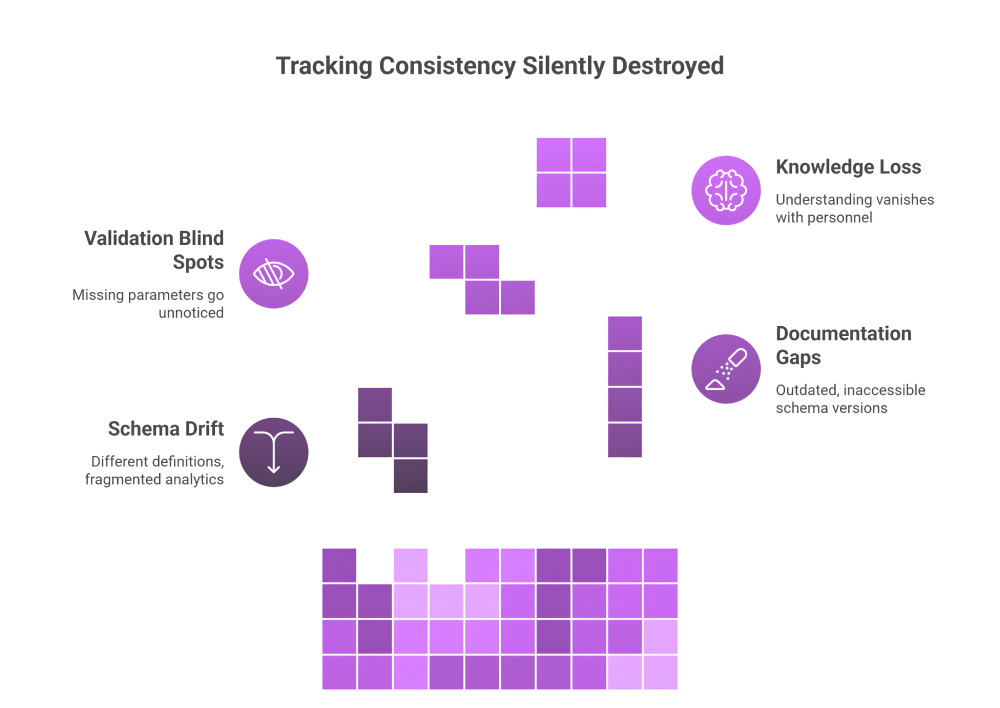Your GA4 dashboard looks flawless. Your tags fire perfectly. But ask two teams to define “conversion” – and you’ll get three answers.
That’s the silent failure of modern analytics: no shared event schema.
The Hidden Foundation of Data Accuracy
Here’s what most organizations overlook: measurement accuracy starts before any tracking happens – in how events are defined. Before you can run a Google Tag Manager audit, optimize containers, or trust your GA4 data integrity, you need a solid event schema. It’s the measurement blueprint that defines what you’re measuring, how you’re measuring it, and why it matters. When that analyst who set up your tracking six months ago leaves for another job, their understanding of why “user_engagement” was defined a certain way leaves with them.
Think of your event schema like architectural plans for a building. You wouldn’t start construction without blueprints, right? Yet, most organizations treat schema creation as an afterthought – a spreadsheet someone updates occasionally, a document buried in Google Drive, or worse, tribal knowledge scattered across teams.
The reality? Your event schema directly determines your analytics foundation. No amount of AI-powered tag audit processes or automated data quality checks can compensate for a poorly designed or inconsistently maintained schema. This is precisely where event schema automation becomes essential – and where most organizations have their biggest blind spot.
Before you can trust your GA4 data integrity, you need a solid event schema – but that’s only one piece of the foundation. Learn how Tag Auditor validates schema implementation accuracy.
The ripple effects of poor schema management:
- Marketing teams track the same action differently across campaigns
- Developers implement events inconsistently because documentation is unclear
- Analytics teams spend hours reconciling conflicting definitions
- Leadership questions reports because numbers don’t align across dashboards
Without a solid measurement blueprint, your entire tag management system operates on shifting ground. Every downstream process – from Google Tag Manager audit cycles to AI-powered tag audit validations, becomes compromised by inconsistent foundations.
What’s Breaking Behind the Scenes
Let’s explore the most common schema failures that silently destroy tracking consistency and compromise your analytics foundation.
- Schema Drift: When Your Blueprint Becomes Outdated
Imagine this: Your team defined a “purchase_complete” event six months ago. Since then, three developers have added parameters, two campaigns introduced custom dimensions, and nobody updated the master schema. Now, the same event captures different data depending on where it fires. And when key team members leave, the rationale behind these definitions disappears entirely—leaving new hires to guess at the original intent.
Consider this scenario: Your e-commerce site tracks purchases with “item_name” on desktop but “product_title” on mobile. Your merchandising analytics becomes fragmented. Cross-device attribution breaks down. Revenue reports don’t reconcile.
This drift happens gradually. What starts as a well-documented GA4 event schema evolves into an inconsistent mess as teams make changes without central coordination.
- The Documentation Gap
Most organizations maintain their measurement blueprint in static documents – spreadsheets, Confluence pages, or shared drives. These documents are outdated the moment they’re created. Worse yet, the person who created that documentation might have moved to a different role or company, taking critical context about parameter definitions and business logic with them.
The issue: Developers can’t find the latest version. Marketers don’t know which parameters are required versus optional. Teams operate from different versions of truth, creating systematic inconsistencies that undermine your entire tag management system.
Even the best schemas lose effectiveness if your container setup isn’t aligned. Discover how GTM Health Checker keeps your container healthy and your schema functional.
- The Implementation Bottleneck
Even with clear schema documentation, translating business requirements into technical implementation creates bottlenecks. Developers spend hours interpreting what “user_engagement” actually means. Marketers wait weeks for custom events to be implemented. Every new campaign requires a complete implementation cycle.
The impact: Product launches get delayed waiting for tracking. Campaign optimizations happen without proper measurement. Teams make decisions with incomplete data because implementing the full schema takes too long.
- Knowledge Loss: When analysts, developers, or marketing managers change jobs, their understanding of event definitions, parameter logic, and implementation decisions vanishes. New team members inherit schemas they don’t fully understand, leading to misinterpretation, incorrect implementations, and measurement gaps that compound over time.
Each of these causes mis-tracking, reporting delays, and poor decisions that undermine your entire tag management system and compromise GA4 data integrity across your organization.
If these bottlenecks sound familiar, it’s time to assess how your current schema setup performs in real-world conditions.
Book a call with Tatvic’s experts to discuss where your measurement framework stands today.
Why Manual Schema Management Fails
Most organizations handle schema management through manual processes – spreadsheet updates, documentation reviews, and periodic alignment meetings. This approach has fundamental limitations that no amount of manual Google Tag Manager audit cycles can overcome.
Here’s the uncomfortable truth: If your schema lives in a spreadsheet, it’s already outdated.
The Core Problems
- You Can’t Maintain Consistency: Different teams interpret schema requirements differently. What one developer considers “complete” implementation, another might view as partial. This inconsistency undermines your entire automated data quality management strategy.
Your marketing team thinks “conversion” means any form submission. Your e-commerce team defines it as completed purchases only. Your product team tracks feature activations as conversions. Without centralized event schema automation, these definitions coexist – creating fragmented reporting that leadership can’t trust.
- You’re Always Behind: Business requirements evolve constantly. By the time you update schema documentation and communicate changes, new requirements have already emerged. You’re perpetually catching up while your GA4 data integrity suffers.
- It Depends on Who’s Documenting: Schema quality varies dramatically based on who creates it. Some teams produce comprehensive documentation. Others create minimal specs that leave critical questions unanswered. This inconsistency means your analytics foundation is only as strong as your weakest documentation.
- It Consumes Valuable Resources: Schema management, updates, and cross-team alignment consume weeks of specialist time – time that could be spent on strategic analysis instead of documentation maintenance.
Moreover, manual approaches provide no real-time visibility. You get periodic snapshots, not ongoing understanding of tracking consistency. Modern businesses can’t operate on quarterly schema reviews when digital properties update daily and tracking requirements change constantly.
Enter Event Schema Automation
What if your event schema could evolve based on business needs, maintain consistency across teams, and stay aligned without constant manual intervention? That’s the fundamental shift event schema automation brings to your analytics foundation.
Event schema automation represents a move from static documentation to living intelligence. Rather than maintaining spreadsheets manually, these systems generate schemas based on industry best practices, business goals, and measurement requirements.
Think of It as an “Always-On Architect”
1. Designs Standardized Event Blueprints
Modern automation systems don’t just store your GA4 event schema—they help design it. By analyzing your business model, customer journeys, and measurement goals, these systems suggest the right events, parameters, and taxonomies automatically.
For instance, the system might recognize you’re an e-commerce business and automatically recommend standard events like “view_item,” “add_to_cart,” “begin_checkout,” and “purchase” – complete with required and optional parameters based on industry benchmarks.
This smart generation process reduces developer dependency and ensures schemas remain lean, consistent, and scalable from day one.
You start with proven templates customized to your business model, giving every team clear, standardized specifications for what and how to track.
2. Syncs Schema Updates Across Teams Instantly
Instead of scattered documentation across multiple tools, automated systems provide a single source of truth for your entire measurement blueprint. Every team: developers, marketers, analysts, QA – accesses the same current schema specifications.
When updates occur, they happen in one place and become immediately visible to everyone.
No more version confusion. No more teams working from outdated documentation. No more implementation inconsistencies caused by communication gaps.
This centralization fundamentally changes how teams collaborate on measurement.
- Developers implement events knowing their work aligns with marketing needs.
- Marketers plan campaigns confident that tracking will capture necessary data.
- Analysts design reports knowing the underlying structure is consistent.
In short, this is automated data quality checks at the source – ensuring consistency before implementation begins, preventing the schema drift that compromises your entire tag management system and GA4 data integrity.
The Results You’ll See
Organizations implementing event schema automation experience measurable improvements across their analytics foundation:
- Consistent Event Tracking Across Web & App: The same “purchase” event captures identical parameters across all touchpoints. Cross-platform analytics finally reconciles accurately because everyone implements from the same measurement blueprint.
- Faster Implementation Cycles: Developers receive clear, standardized specifications immediately. Product launches proceed without measurement bottlenecks because schema requirements are immediately accessible and unambiguous.
- Fewer Reporting Disputes: When schema specifications are clear, centralized, and accessible, teams stop arguing about definitions. This reduction in friction accelerates everything – from campaign launches to product releases to reporting cycles.
- Reliable GA4 Data: With consistent schema implementation, your GA4 data integrity becomes trustworthy. Leadership makes confident decisions based on analytics that actually reflect reality rather than measurement inconsistencies.
The Bigger Picture: Measurement Excellence
Event schema automation doesn’t work in isolation. It’s the foundational pillar in a comprehensive approach to tracking consistency and GA4 data integrity.
Here’s how it fits into Tatvic’s measurement excellence framework:
Pillar 1: Event Schema Automation provides the measurement blueprint—ensuring definitions stay current, consistent, and aligned across teams. It’s the foundation upon which all other measurement processes build.
Pillar 2: Tag Auditor validates that events fire correctly according to schema specifications, catching implementation issues through automated data quality checks before they reach production.
Pillar 3: GTM Health Checker ensures your container implements the schema efficiently, maintaining configuration health and preventing conflicts that undermine tracking consistency.
Pillar 4: Data Sanity Automation verifies that collected data matches schema expectations throughout its journey into GA4, providing end-to-end validation of your analytics foundation.
Pillar 5: Additional advanced capabilities complete the framework, addressing continuous optimization and intelligence across your measurement ecosystem.
Together, these create comprehensive protection for measurement integrity – from schema design through implementation to validation. This integrated approach represents a fundamental shift in how organizations approach analytics infrastructure.
Instead of treating schema as static documentation, you maintain a living measurement blueprint that evolves with your business. Each element addresses a specific vulnerability. Event Schema Automation provides the blueprint. AI-powered tag audit processes confirm it’s implemented correctly. The GTM Health Checker ensures container optimization. Data sanity checks verify end results.
This is how Tatvic AI solutions transform analytics from fragile to reliable – not through isolated point solutions, but through integrated systems that protect measurement integrity at every stage.
Your Path Forward
The evolution of event schema management points toward automation, clarity, and consistency. Organizations adopting these approaches gain measurable advantages, faster implementations, more consistent measurement, and greater confidence in analytics foundations.
Manual schema management will always create bottlenecks. Static documentation will always drift from reality. The question isn’t whether schema inconsistencies exist in your measurement; they likely do.
The real question: Will you discover and address schema gaps before they compromise your entire analytics foundation and impact business decisions across the organization?
Understanding your schema’s actual state, rather than assuming it’s well-documented – represents the first step toward building truly reliable measurement infrastructure that scales with your business growth.
Stop treating your event schema as an afterthought. Start building it as the strategic foundation it should be. The organizations winning with analytics aren’t just collecting more data – they’re ensuring every data point starts from a solid, consistent measurement blueprint.
Ready to uncover the silent gaps in your measurement?
Talk to a Tatvic expert to get a Schema Health Check – and see how Event Schema Automation can transform your GA4 data integrity from inconsistent to insight-ready.





